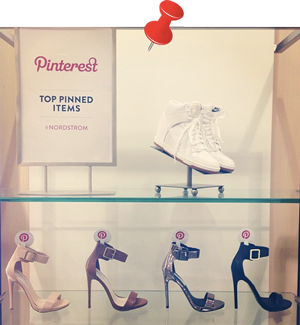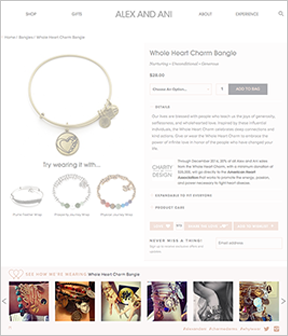
40% of all social media users have purchased items online or in-store after sharing or "favoriting" them on Facebook, Twitter or Pinterest.
Retailers are investing more time and money in their social media strategies. As many as 66% of retailers said they have a social strategy in place in 2014, versus 60% in 2013, according to Retail TouchPoints research.
When used effectively, social media can help retailers generate buzz and even boost both online and in-store traffic. But retail executives, analysts and experts continue to debate social media's impact on bottom-line results.
Recent industry research confirms that social media can influence sales both online and in the store: 40% of all social media users have purchased items online or in-store after sharing or "favoriting" them on Facebook, Twitter or Pinterest, according to research from Vision Critical. The survey of 5,900 consumers confirmed that social media drives approximately the same amount of sales both in-store and online.
But how can retailers tap Facebook, Twitter and other social channels, such as Pinterest, to accelerate the sales cycle from initial research to the final purchase decision? And more importantly, how can retailers measure social media's overall impact on the brick-and-mortar business?
Experts indicate that social media can be effectively integrated into brick-and-mortar strategies; and while some forward-thinking companies are seeing initial success with this approach, it's still early for the industry as a whole.
"No one's really cracked the code on it yet," said Laura Davis-Taylor, SVP of Omnichannel Experience at The Integer Group, in an interview with Retail TouchPoints. "In some part due to strategy and other part due to the tools. It's still early days but there are a lot of opportunities."

"Customers speak to us through their pins about which items are most relevant and exciting, and the top-pinned items in our stores is an attempt to bring these pinned items to life."
One initial opportunity that some merchants may be missing is promoting and encouraging social engagement in the store. Unfortunately, many retailers are holding on to the misconception that because social media is a digital activity, it is best promoted online.
Recent research confirms this belief among industry executives. Retailers use email (79%) and their web site (77%) to promote their social commerce services to customers, according to the Retail TouchPoints Social Commerce Survey. Only 24% of retailers said they promoted their social presence in-store at the POS, and even fewer said they used in-store digital signage (21%).
But at least one retailer is leading the way toward a successful in-store/social connection. In 2013, Nordstrom started using its Pinterest fan base to identify popular products and encourage social engagement. These "most-pinned products" were then promoted in-store with special signage and unique merchandise designs.
"What's great about social media is that it creates a bigger platform for customers to share their experiences with us and with each other," said Dan Evans, Business PR Director for Nordstrom, in an interview with Retail TouchPoints. "Customers speak to us through their pins about which items are most relevant and exciting, and the top-pinned items in our stores is an attempt to bring these pinned items to life. We hope everyone finds them as inspiring as our Pinterest followers do."
Other retailers may be missing out on new marketing opportunities because they continue to view social media and the store as separate channels addressing different parts of the sales funnel.
"Social media is currently being used as a brand awareness, top-of-the-funnel initiative," noted Pau Sabria, Co-Founder of Olapic. "And in-store retail is used as an end-of-the-funnel channel, or a sales channel. These are very different approaches and rarely compete with one another. I believe that clever strategies feed off each other; for example how Nordstrom is identifying the products that have been most pinned on Pinterest."
In another example, cosmetics company 100% Pure is merging the digital and physical worlds by placing events at the center of its strategies. The brand is promoting in-store events using a designated hash tag, encouraging customers to share images of themselves once they enter a location.
"We're trying to refine our events strategy, but the most successful thing we've done is put signage in stores and encourage people to Instagram about the event and build dialogue," said Ric Kostick, CEO of 100% Pure. "We use the company hash tag and encourage everyone to use it. We may even give out incentives to really get them talking [about the brand] during our events."


"Companies need to understand what channels their customers are using most frequently. You may build a Facebook fan page but then find your consumers are using Twitter more frequently."
When crafting plans for integrating social media into the brick-and-mortar store, retailers should consider a number of elements, according to Davis-Taylor, including: The store, the category, the product and what makes it unique, and current shopping behaviors.
But most importantly, retailers need to determine how they can amplify consumers' shopping behaviors and encourage them to talk more about their experiences throughout the entire brand journey.
"Retailers need to look at before, during and after the purchase and consider their consumers' shopping behaviors," Davis-Taylor explained. However, because consumers continue to hop between channels and devices throughout their browsing and buying journeys, there no longer is a standard path to purchase, she added. Instead retailers "need to create a shopping story."
Davis-Taylor suggested that brands and retailers ask themselves the following questions:
Additionally, to ensure that marketing and engagement strategies are relevant, retailers need to clearly identify target customers and their preferred social channels.
"Companies need to understand what channels their customers are using most frequently," said Omer Minkara, Senior Research Analyst of the Contact Center and Customer Experience Management Practice at Aberdeen Group. "You may build a Facebook fan page but then find your consumers are using Twitter more frequently."
Minkara recommended that retailers tap surveys, focus groups and other voice of the customer (VoC) programs to establish a baseline of "understanding where your consumers want to interact with your firm. These programs can help you understand what your customers prefer."
However, merchants also should consider the value of specific social channels. For example, Instagram is a valuable network for retailers to give consumers a "behind-the-scenes" look at their brand, while Twitter is a valuable service channel.
"You have to determine what problems you're trying to solve," said Kyle Wegner, Associate Director of Digital Strategy at The Integer Group. "For the majority of brands and retailers, there's a place in the world for most social platforms. Each site can solve a different problem for an organization."
In June 2013, Facebook started supporting hash tags, which offered users a new way to track conversations about trending topics. The development also gave retailers a new opportunity to create hash tag campaigns that spanned across three key channels: Facebook, Twitter and Instagram.
"Within the last year it has become easier for brands and retailers to create cohesive social campaigns," Wegner said. "You used to have to decide where to push people. Were you going to do a Facebook program, or an Instagram and Twitter program? If it was Facebook, you couldn't use hash tags."
Now that hash tags are universal, retailers can use a single tag for several social channels, which makes it easier for consumers to share insights and retailers to collect and track feedback, Wegner added. "You don't have to make a choice for your shopper anymore."
Retailers can refer to hash tags and other social feedback to keep a pulse on customer sentiment. By integrating this feedback with CRM data, retailers can create a comprehensive picture of individual customers and their unique shopping journeys.
Retail "Leaders" are more likely to incorporate social media into their CRM initiatives, according to Aberdeen Group research. As many as 40% of business "Leaders" incorporate social media touch points into their CRM and/or customer experience management initiatives, compared to only 26% of "Followers."
In the report, titled: Social Powers Activate: Engineering Social Engagement To Win The Hidden Sales Cycle, Aberdeen also indicated that progressive organizations leverage "active listening," which "combines social media monitoring with an infrastructure of action."
Key capabilities of active listening include:
If a customer references a brand, product or service on social media, a retailer can "then attribute that feedback to a specific customer record in the CRM system," Minkara explained. Tying social data with different types of account data, such as credit card information, then allows retailers to "attribute the customer record in the CRM system with their in-store purchase. By using technology tools such as customer analytics, companies can then map out the entire journey and see what particular activities encouraged buyers to visit their store and contributed to them making a purchase."
Loyalty programs also can help close the loop between social feedback and in-store purchases.
"One of the challenges of social media is that it is somewhat individual agnostic," noted Bob Heaney, Principal Analyst of the Retail/Wholesale Markets and e-Commerce Practice at Aberdeen Group. "If a shopper goes to a retailer's Facebook or Pinterest page, the company can get information about his or her general interests and what they're doing on that site. But unless it's tied to a loyalty program and a customer is opted in, you don't have the intelligence into who that person is and you can't see what they're doing differently over time. Additionally, if behavior or supplemental activity is initiated via mobile or social devices, retailers may not be able to link the specific device-level activity back to a 360-degree view of an individual consumer across all omnichannel points of engagement."

"Many brands are beginning to realize that social media can be used as a powerful tool to drive in-store engagement and sales. For many consumers, social media can provide inspiration on how to decorate a space, plan an outfit or see how it fits on a real person instead of a traditional model."
By following their favorite brands and retailers on social networks, consumers can gain access to an insider's view of companies and products as well as a first look at new releases, offers, contests and giveaways.
Today's retail environment has entered a "new social norm," with more people using social networks on a daily basis, according to Nielsen in a recent report. The Digital Consumer report concluded that 64% of social media users tap into sites at least once a day on their computers. Approximately half (47%) of social media subscribers use their smartphones to access social networks.
Progressive retailers such as Nordstrom, Alex and Ani, and Duane Reade are embracing social channels, including Facebook, Pinterest, Twitter and Instagram, to boost bottom-line results.
"Many brands are beginning to realize that social media can be used as a powerful tool to drive in-store engagement and sales," Olapic's Sabria said. "For many consumers, social media can provide inspiration on how to decorate a space, plan an outfit or see how it fits on a real person instead of a traditional model."
But retailers' participation in social channels should not end once a customer completes a purchase. To drive ongoing sales and promote long-term loyalty, forward-thinking merchants are using social networks to build ongoing relationships and provide value to their customers over time.
"While social media can help promote flash sales and short-term objectives, and overall, help get the word out, it's generally a long-term play," Wegner explained. "It's not as simple as using a hash tag on in-store promotions and calling it a day. That doesn't give your shoppers any reason to engage with your brand or even recall it after they visit a store. You have to think about the utility and value you're going to provide to your customers."
With more than four million followers on Pinterest, 423,000 followers on Instagram and more than 2.5 million "likes" on Facebook, Nordstrom has a large, passionate community of customers that actively engage with the brand.
"What's great about social media is that it creates a bigger platform for customers to share their experiences with us and with each other," said Dan Evans, Business PR Director for Nordstrom, in an interview with Retail TouchPoints. "We want to create a seamless shopping experience, whether customers are shopping in store, online or through our mobile app. Social media gives us a way to engage with customers in real-time as they shop. We love to be there to help them find that perfect item."
Evans clarified that Nordstrom "doesn't have a channel strategy; we have a customer strategy. Social media is another way for us to stay connected with customers throughout the entire shopping experience."
Communication and engagement have become even more seamless and compelling since Nordstrom implemented a series of in-store tactics to promote its social presence. For example, the retailer is using special displays and signage to promote items popular on social networks.
"Customers speak to us through their pins about which items are most relevant and exciting, and the top-pinned items in our stores is an attempt to bring these pinned items to life," according to Evans.
As shopping preferences continue to shift, Nordstrom will strive to evolve with them, "no matter how they choose to engage or shop," Evans reported. "We realize the definition of service is changing, too. We continue to listen and learn from customers through social media platforms like Pinterest and do our best to serve them on their terms."

Product detail pages are adorned with photos of fans sporting Alex and Ani jewelry, a social commerce strategy that helps show products "in the wild." This "shop the look" component has been "quite effective at lifting time spent on the site, average order value and conversion rates."
Social media and real-time customer engagement have a "front row seat" in the digital program at Alex and Ani, said Ryan Bonifacino, VP of Digital Strategy at Alex and Ani, in an interview with Retail TouchPoints.
Alex and Ani Founder and CEO Carolyn Rafaelian established the jewelry brand and retailer to "put customers first with authenticity no matter how large of a company we become," Bonifacino said. "The company makes large investments not only into personnel and agency relationships but also sophisticated social listening, social content management/distribution and social analytics tools."
To establish and cement relationships with loyal customers, each of Alex and Ani's stores nationwide includes a social media liaison who stays in constant contact with the retail social team at company headquarters.
Having these local representatives helps create more relevant campaigns and events, resulting in "extremely high engagement," Bonifacino explained. They also "add to the sense of loyalty our in-store and crossover customers have with our brand." Alex and Ani also has seen success with a user-generated content strategy, which is fueled by Olapic technology.
Product detail pages are adorned with photos of fans sporting Alex and Ani jewelry, a social commerce strategy that helps show products "in the wild," Bonifacino noted. This "shop the look" component has been "quite effective at lifting time spent on the site, average order value and conversion rates."
The user-generated content initiative has been so fruitful that Alex and Ani plans to integrate consumer photos from across social networks into its new brick-and-mortar strategy that features iBeacon technology.
"Our digital strategy includes a very forward-thinking approach to the digitization of in-store retail experiences," Bonifacino said. "We are oftentimes the first brand in our category to test and scale new and emerging technologies - as was the case with iBeacon technology. This technology will serve as the backbone to a handheld experience that brings both product information and user-generated content from social media through Olapic into the hands of our customers and fans."

New York City-based pharmacy chain Duane Reade takes a highly localized approach to its strategies for merging social media and its stores.
Specifically, the retailer embraces a hybrid of localized social asset management and influencer advocate marketing, both of which are part of Duane Reade's patented "Parallel Persuasion Equation," according to Calvin Peters, PR and Digital Communications Manager for Duane Reade. The Parallel Persuasion Equation is: Brand Advocacy + Brand Voice + PR Integration + Conversation Relevance = ROI.
Duane Reade has rolled out a series of notable social amplification programs to promote its private label legwear line, such as the Boo-Ti-Ful Legs campaign. Taking an omnichannel approach to these initiatives, the retailer integrates social media with mobile and the store, focusing on user-generated content and images.
Marketing campaigns and strategies "are seamlessly implemented across the board," said Peters in an interview with Retail TouchPoints. "We are always looking for relevant ways to communicate value-added content to our customers when it's most actionable in their daily routines."
Duane Reade has implemented a variety of in-store marketing initiatives, such as strategically placed in-store creative assets and in-store radio. The retailer also recently launched a 10-store iBeacon test, which will allow Duane Reade to "integrate our core authentic user-generated content and value-added assets per category at the precise point of decision in-store," Peters said. All content and assets will be custom-tailored to individual customers and their prior purchases.
Peters added that the in-store assets, radio and iBeacon roll out will all play an important role in reaching customers in a relevant and compelling way while they're browsing in stores or checking out at the point of sale.

"When I see social strategies across the entire shopping journey, what I see missing is contextual relevance. People love social media but brands and retailers are not always thinking about understanding how consumers are using it organically before, during and after they shop."
Innovative retailers are tapping mobile technology to help blur the lines between social networks and brick-and-mortar stores.For example, in-store Wi-Fi and beacon technology can help link online shopping behaviors with in-store browsing and buying patterns.
"Companies are trying to close the loop by tracing shopper profiles throughout the entire lifecycle of activities and touch points," Heaney of Aberdeen Group said. "One way to connect shopper sales activities and all-device channel interests is to tie social and mobile activity to web and in-store location-sensing technology via loyalty program extensions and device-agnostic shopper profiles."
Closing the information loop will provide retailers with the information they need to make in-store social engagement more relevant. "When I see social strategies across the entire shopping journey, what I see missing is contextual relevance," Davis-Taylor reported. "People love social media but brands and retailers are not always thinking about understanding how consumers are using it organically before, during and after they shop."
Mobile devices present a variety of opportunities for consumers to connect social data and in-store experiences, Davis-Taylor explained. For example, shoppers can tap their smartphones to access product information and determine how many "likes" an item has received on social media.
RFID and NFC also can help create more connected experiences. Using their smartphones, shoppers can activate digital signage on RFID-tagged items to access ratings and reviews or user-generated content, added Davis-Taylor. "The ability to connect the information cloud to the shopper while they're in the moment is a really exciting concept."
As consumers continue to expand their use of digital channels and technologies in their everyday lives, retailers will have more opportunities to unify the social and brick-and-mortar experience.